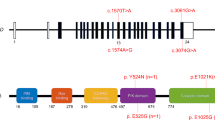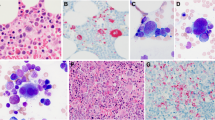Abstract
Killer-cell immunoglobulin-like receptors (KIRs) are a structurally and functionally diverse family of molecules expressed by natural killer (NK) cells and T-cell subsets. The most centromeric gene in the human KIR cluster is KIR3DL3, a framework gene that is present in all haplotypes. KIR3DL3 has only one immunoreceptor tyrosine-based inhibitory motif and lacks the exon encoding the stem between the Immunoglobulin domains and the transmembrane region. We have investigated expression of KIR3DL3 in blood and decidual NK cells by reverse transcriptase polymerase chain reaction (RT-PCR) and protein analysis using a KIR3DL3-specific monoclonal antibody, CH21. KIR3DL3 mRNA was only detected in the CD56bright subset in cells from peripheral blood and in CD56bright decidual NK cells. The CD56bright NK92 cell line was also positive. Quantitative RT-PCR indicated a trend for higher expression of KIR3DL3 in female peripheral blood mononuclear cells compared to that in male. Using a bisulphite conversion method, we found that the promoter of KIR3DL3 was strongly methylated. Surface protein expression was detectable after demethylation. Like other KIRs, KIR3DL3 is highly polymorphic, and we detected 14 variants in 25 unrelated individuals. Nucleotide substitutions were scattered throughout the sequence, with a cluster of alleles at the start of the transmembrane region at the site where the remnant of the linking stem present in other KIR is found. We conclude that the KIR3DL3 gene is not a pseudogene but encodes a protein that is not expressed in healthy individuals. Protein expression might be induced under certain developmental or pathological situations.








Similar content being viewed by others
References
Blery M, Olcese L, Vivier E (2000) Early signaling via inhibitory and activating NK receptors. Hum Immunol 61:51–64
Cantoni C, Verdiani S, Falco M, Pessino A, Cilli M, Conte R, Pende D, Ponte M, Mikaelsson MS, Moretta L, Biassoni R (1998) p49, a putative HLA class I-specific inhibitory NK receptor belonging to the immunoglobulin superfamily. Eur J Immunol 28:1980–1990
Chan HW, Kurago ZB, Stewart CA, Wilson MJ, Martin MP, Mace BE, Carrington M, Trowsdale J, Lutz CT (2003) DNA methylation maintains allele-specific KIR gene expression in human natural killer cells. J Exp Med 197:245–255
Goodridge JP, Witt CS, Christiansen FT, Warren HS (2003) KIR2DL4 (CD158d) genotype influences expression and function in NK cells. J Immunol 171:1768–1774
Guethlein LA, Flodin LR, Adams EJ, Parham P (2002) NK cell receptors of the orangutan (Pongo pygmaeus): a pivotal species for tracking the coevolution of killer cell Ig-like receptors with MHC-C. J Immunol 169:220–229
Hiby SE, King A, Sharkey AM, Loke YW (1997) Human uterine NK cells have a similar repertoire of killer inhibitory and activatory receptors to those found in blood, as demonstrated by RT-PCR and sequencing. Mol Immunol 34:419–430
Hiby SE, Lough M, Keverne EB, Surani MA, Loke YW, King A (2001) Paternal monoallelic expression of PEG3 in the human placenta. Hum Mol Genet 10:1093–1100
Hoelsbrekken SE, Nylenna O, Saether PC, Slettedal IO, Ryan JC, Fossum S, Dissen E (2003) Cutting edge: molecular cloning of a killer cell Ig-like receptor in the mouse and rat. J Immunol 170:2259–2263
Hsu KC, Liu XR, Selvakumar A, Mickelson E, O’Reilly RJ, Dupont B (2002) Killer Ig-like receptor haplotype analysis by gene content: evidence for genomic diversity with a minimum of six basic framework haplotypes, each with multiple subsets. J Immunol 169:5118–5129
Husain Z, Alper CA, Yunis EJ, Dubey DP (2002) Complex expression of natural killer receptor genes in single natural killer cells. Immunology 106:373–380
Khakoo SI, Rajalingam R, Shum BP, Weidenbach K, Flodin L, Muir DG, Canavez F, Cooper SL, Valiante NM, Lanier LL, Parham P (2000) Rapid evolution of NK cell receptor systems demonstrated by comparison of chimpanzees and humans. Immunity 12:687–698
Lanier LL, Cwirla S, Federspiel N, Phillips JH (1986) Human natural killer cells isolated from peripheral blood do not rearrange T cell antigen receptor beta chain genes. J Exp Med 163:209–214
Lanier LL, Corliss BC, Wu J, Leong C, Phillips JH (1998) Immunoreceptor DAP12 bearing a tyrosine-based activation motif is involved in activating NK cells. Nature 391:703–707
Long EO, Colonna M, Lanier LL (1996) Inhibitory MHC class I receptors on NK and T cells: a standard nomenclature. Immunol Today 17:100
Long EO, Barber DF, Burshtyn DN, Faure M, Peterson M, Rajagopalan S, Renard V, Sandusky M, Stebbins CC, Wagtmann N, Watzl C (2001) Inhibition of natural killer cell activation signals by killer cell immunoglobulin-like receptors (CD158). Immunol Rev 181:223–233
Mingari MC, Schiavetti F, Ponte M, Vitale C, Maggi E, Romagnani S, Demarest J, Pantaleo G, Fauci AS, Moretta L (1996) Human CD8+ T lymphocyte subsets that express HLA class I-specific inhibitory receptors represent oligoclonally or monoclonally expanded cell populations. Proc Natl Acad Sci U S A 93:12433–12438
Moffett-King A (2002) Natural killer cells and pregnancy. Nat Rev Immunol 2:656–663
Moretta A, Bottino C, Pende D, Tripodi G, Tambussi G, Viale O, Orengo A, Barbaresi M, Merli A, Ciccone E et al (1990) Identification of four subsets of human CD3-CD16+ natural killer (NK) cells by the expression of clonally distributed functional surface molecules: correlation between subset assignment of NK clones and ability to mediate specific alloantigen recognition. J Exp Med 172:1589–1598
Pando MJ, Gardiner CM, Gleimer M, McQueen KL, Parham P (2003) The protein made from a common allele of KIR3DL1 (3DL1*004) is poorly expressed at cell surfaces due to substitution at positions 86 in Ig domain 0 and 182 in Ig domain 1. J Immunol 171:6640–6649
Rajalingam R, Hong M, Adams EJ, Shum BP, Guethlein LA, Parham P (2001) Short KIR haplotypes in pygmy chimpanzee (Bonobo) resemble the conserved framework of diverse human KIR haplotypes. J Exp Med 193:135–146
Rajalingam R, Parham P, Abi-Rached L (2004) Domain shuffling has been the main mechanism forming new hominoid killer cell Ig-like receptors. J Immunol 172:356–369
Robinson J, Waller MJ, Stoehr P, Marsh SG (2005) IPD—the immuno polymorphism database. Nucleic Acids Res 33:D523–526
Santourlidis S, Trompeter HI, Weinhold S, Eisermann B, Meyer KL, Wernet P, Uhrberg M (2002) Crucial role of DNA methylation in determination of clonally distributed killer cell Ig-like receptor expression patterns in NK cells. J Immunol 169:4253–4261
Shilling HG, Guethlein LA, Cheng NW, Gardiner CM, Rodriguez R, Tyan D, Parham P (2002) Allelic polymorphism synergizes with variable gene content to individualize human KIR genotype. J Immunol 168:2307–2315
Steffens U, Vyas Y, Dupont B, Selvakumar A (1998) Nucleotide and amino acid sequence alignment for human killer cell inhibitory receptors (KIR). Tissue Antigens 51:398–413
Stewart CA, Van Bergen J, Trowsdale J (2003) Different and divergent regulation of the KIR2DL4 and KIR3DL1 promoters. J Immunol 170:6073–6081
Torkar M, Norgate Z, Colonna M, Trowsdale J, Wilson MJ (1998) Isotypic variation of novel immunoglobulin-like transcript/killer cell inhibitory receptor loci in the leukocyte receptor complex. Eur J Immunol 28:3959–3967
Trowsdale J (2001) Genetic and functional relationships between MHC and NK receptor genes. Immunity 15:363–374
Trowsdale J, Barten R, Haude A, Stewart CA, Beck S, Wilson MJ (2001) The genomic context of natural killer receptor extended gene families. Immunol Rev 181:20–38
Uhrberg M, Valiante NM, Young NT, Lanier LL, Phillips JH, Parham P (2001) The repertoire of killer cell Ig-like receptor and CD94:NKG2A receptors in T cells: clones sharing identical alpha beta TCR rearrangement express highly diverse killer cell Ig-like receptor patterns. J Immunol 166:3923–3932
Valiante NM, Uhrberg M, Shilling HG, Lienert-Weidenbach K, Arnett KL, D’Andrea A, Phillips JH, Lanier LL, Parham P (1997) Functionally and structurally distinct NK cell receptor repertoires in the peripheral blood of two human donors. Immunity 7:739–751
Verma S, King A, Loke YW (1997) Expression of killer cell inhibitory receptors on human uterine natural killer cells. Eur J Immunol 27:979–983
Vilches C, Parham P (2002) KIR: diverse, rapidly evolving receptors of innate and adaptive immunity. Annu Rev Immunol 20:217–251
Vilches C, Rajalingam R, Uhrberg M, Gardiner CM, Young NT, Parham P (2000) KIR2DL5, a novel killer-cell receptor with a D0-D2 configuration of Ig-like domains. J Immunol 164:5797–5804
Welch AY, Kasahara M, Spain LM (2003) Identification of the mouse killer immunoglobulin-like receptor-like (Kirl) gene family mapping to chromosome X. Immunogenetics 54:782–790
Wilson MJ, Torkar M, Haude A, Milne S, Jones T, Sheer D, Beck S, Trowsdale J (2000) Plasticity in the organization and sequences of human KIR/ILT gene families. Proc Natl Acad Sci U S A 97:4778–4783
Yawata M, Yawata N, Abi-Rached L, Parham P (2002) Variation within the human killer cell immunoglobulin-like receptor (KIR) gene family. Crit Rev Immunol 22:463–482
Acknowledgements
We would like to thank Jacquie Northfield and Nigel Miller for technical assistance, Paul Norman for helpful advice and Jenny Connor for typing the manuscript. This study was funded by National Institutes of Health RO1-HD39670-01, British Heart Foundation, Wellcome Trust and the Isaac Newton Trust. The experiments performed during this study comply with current British laws.
Author information
Authors and Affiliations
Corresponding author
Rights and permissions
About this article
Cite this article
Trundley, A.E., Hiby, S.E., Chang, C. et al. Molecular characterization of KIR3DL3. Immunogenetics 57, 904–916 (2006). https://doi.org/10.1007/s00251-005-0060-7
Received:
Accepted:
Published:
Issue Date:
DOI: https://doi.org/10.1007/s00251-005-0060-7




